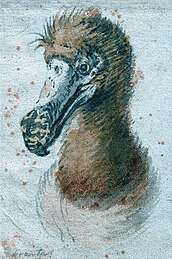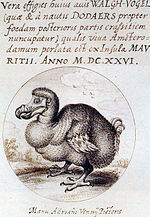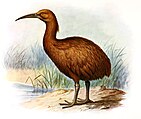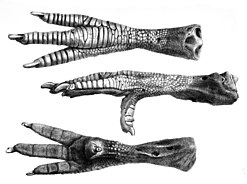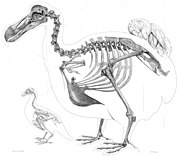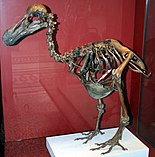Dodo
| Dodo Temporal range:
| |
|---|---|

| |
| Dodo skeleton cast (left) and model based on modern research (right), at Oxford University Museum of Natural History | |
| Scientific classification | |
| Domain: | Eukaryota |
| Kingdom: | Animalia |
| Phylum: | Chordata |
| Class: | Aves |
| Order: | Columbiformes |
| Family: | Columbidae |
| Subfamily: | †Raphinae |
| Genus: | †Raphus Brisson, 1760 |
| Species: | †R. cucullatus
|
| Binomial name | |
| †Raphus cucullatus (Linnaeus, 1758)
| |
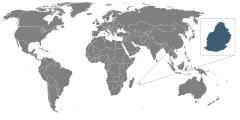
| |
| Location of Mauritius (in blue) | |
| Synonyms | |
| |
The dodo (Raphus cucullatus) is an
The first recorded mention of the dodo was by Dutch sailors in 1598. In the following years, the bird was hunted by sailors and invasive species, while its habitat was being destroyed. The last widely accepted sighting of a dodo was in 1662. Its extinction was not immediately noticed, and some considered the bird to be a myth. In the 19th century, research was conducted on a small quantity of remains of four specimens that had been brought to Europe in the early 17th century. Among these is a dried head, the only soft tissue of the dodo that remains today. Since then, a large amount of subfossil material has been collected on Mauritius, mostly from the Mare aux Songes swamp. The extinction of the dodo within less than a century of its discovery called attention to the previously unrecognised problem of human involvement in the disappearance of entire species. The dodo achieved widespread recognition from its role in the story of Alice's Adventures in Wonderland, and it has since become a fixture in popular culture, often as a symbol of extinction and obsolescence.
Taxonomy
The dodo was variously declared a small
Strickland and Melville established that the dodo was
Throughout the 19th century, several species were classified as
For many years the dodo and the Rodrigues solitaire were placed in a
Evolution

In 2002, American geneticist
| |||||||||||||||||||||||||||||||
A similar cladogram was published in 2007, inverting the placement of Goura and Didunculus and including the
The 2002 study indicated that the ancestors of the dodo and the solitaire diverged around the
Etymology

One of the original names for the dodo was the Dutch "Walghvoghel", first used in the journal of Dutch
On their left hand was a little island which they named Heemskirk Island, and the bay it selve they called Warwick Bay... Here they taried 12. daies to refresh themselues, finding in this place great quantity of foules twice as bigge as swans, which they call Walghstocks or Wallowbirdes being very good meat. But finding an abundance of pigeons & popinnayes [parrots], they disdained any more to eat those great foules calling them Wallowbirds, that is to say lothsome or fulsome birdes.[25][26]
Another account from that voyage, perhaps the first to mention the dodo, states that the Portuguese referred to them as penguins. The meaning may not have been derived from
The
The Latin name cucullatus ("hooded") was first used by
Description

As no complete dodo specimens exist, its external appearance, such as plumage and colouration, is hard to determine.
Subfossil remains and remnants of the birds that were brought to Europe in the 17th century show that dodos were very large birds, measuring around 62.6–75 cm (2.05–2.46 ft) in height.
Skeleton

The skull of the dodo differed much from those of other pigeons, especially in being more robust, the bill having a hooked tip, and in having a short cranium compared to the jaws. The upper bill was nearly twice as long as the cranium, which was short compared to those of its closest pigeon relatives. The openings of the bony nostrils were elongated along the length of the beak, and they contained no bony septum. The cranium (excluding the beak) was wider than it was long, and the

The dodo had about nineteen presynsacral vertebrae (those of the neck and
Many of the skeletal features that distinguish the dodo and the Rodrigues solitaire, its closest relative, from other pigeons have been attributed to their flightlessness. The pelvic elements were thicker than those of flighted pigeons to support the higher weight, and the
Contemporary descriptions
Most contemporary descriptions of the dodo are found in
Blue parrots are very numerous there, as well as other birds; among which are a kind, conspicuous for their size, larger than our swans, with huge heads only half covered with skin as if clothed with a hood. These birds lack wings, in the place of which 3 or 4 blackish feathers protrude. The tail consists of a few soft incurved feathers, which are ash coloured. These we used to call 'Walghvogel', for the reason that the longer and oftener they were cooked, the less soft and more insipid eating they became. Nevertheless their belly and breast were of a pleasant flavour and easily masticated.[45]
One of the most detailed descriptions is by Herbert in A Relation of Some Yeares Travaille into Afrique and the Greater Asia from 1634:
First here only and in Dygarrois [Rodrigues] is generated the Dodo, which for shape and rareness may antagonize the Phoenix of Arabia: her body is round and fat, few weigh less than fifty pound. It is reputed more for wonder than for food, greasie stomackes may seeke after them, but to the delicate they are offensive and of no nourishment. Her visage darts forth melancholy, as sensible of Nature's injurie in framing so great a body to be guided with complementall wings, so small and impotent, that they serve only to prove her bird. The halfe of her head is naked seeming couered with a fine vaile, her bill is crooked downwards, in midst is the thrill [nostril], from which part to the end tis a light green, mixed with pale yellow tincture; her eyes are small and like to Diamonds, round and rowling; her clothing downy feathers, her train three small plumes, short and inproportionable, her legs suiting her body, her pounces sharpe, her appetite strong and greedy. Stones and iron are digested, which description will better be conceived in her representation.[46]
Contemporary depictions

The travel journal of the Dutch ship Gelderland (1601–1603), rediscovered in the 1860s, contains the only known sketches of living or recently killed specimens drawn on Mauritius. They have been attributed to the professional artist Joris Joostensz Laerle, who also drew other now-extinct Mauritian birds, and to a second, less refined artist.[47] Apart from these sketches, it is unknown how many of the twenty or so 17th-century illustrations of the dodos were drawn from life or from stuffed specimens, which affects their reliability.[23] Since dodos are otherwise only known from limited physical remains and descriptions, contemporary artworks are important to reconstruct their appearance in life. While there has been an effort since the mid-19th century to list all historical illustrations of dodos, previously unknown depictions continue to be discovered occasionally.[48]
The traditional image of the dodo is of a very fat and clumsy bird, but this view may be exaggerated. The general opinion of scientists today is that many old European depictions were based on overfed captive birds or crudely stuffed specimens.[49] It has also been suggested that the images might show dodos with puffed feathers, as part of display behaviour.[41] The Dutch painter Roelant Savery was the most prolific and influential illustrator of the dodo, having made at least twelve depictions, often showing it in the lower corners. A famous painting of his from 1626, now called Edwards's Dodo as it was once owned by the ornithologist George Edwards, has since become the standard image of a dodo. It is housed in the Natural History Museum, London. The image shows a particularly fat bird and is the source for many other dodo illustrations.[50][51]
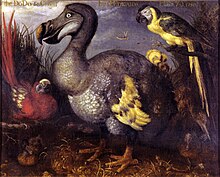
An Indian
All post-1638 depictions appear to be based on earlier images, around the time reports mentioning dodos became rarer. Differences in the depictions led ornithologists such as
Behaviour and ecology
Little is known of the behaviour of the dodo, as most contemporary descriptions are very brief. Based on weight estimates, it has been suggested the male could reach the age of 21, and the female 17.

The preferred habitat of the dodo is unknown, but old descriptions suggest that it inhabited the woods on the drier coastal areas of south and west Mauritius. This view is supported by the fact that the
Many endemic species of Mauritius became extinct after the arrival of humans, so the
Diet and feeding
A 1631 Dutch letter (long thought lost, but rediscovered in 2017) is the only account of the dodo's diet, and also mentions that it used its beak for defence. The document uses
The mayors are superb and proud. They presented themselves with an unyielding, stern face and wide open mouth, very jaunty and audacious of gait. They did not want to budge before us; their war weapon was the mouth, with which they could bite fiercely. Their food was raw fruit; they were not dressed very well, but were rich and fat, therefore we brought many of them on board, to the contentment of us all.[66]
In addition to fallen fruits, the dodo probably subsisted on nuts, seeds, bulbs, and roots.
Skeletal elements of the upper jaw appear to have been
Several contemporary sources state that the dodo used Gastroliths (gizzard stones) to aid digestion. The English writer Sir Hamon L'Estrange witnessed a live bird in London and described it as follows:
About 1638, as I walked London streets, I saw the picture of a strange looking fowle hung out upon a clothe and myselfe with one or two more in company went in to see it. It was kept in a chamber, and was a great fowle somewhat bigger than the largest Turkey cock, and so legged and footed, but stouter and thicker and of more erect shape, coloured before like the breast of a young cock fesan, and on the back of a dunn or dearc colour. The keeper called it a Dodo, and in the ende of a chymney in the chamber there lay a heape of large pebble stones, whereof hee gave it many in our sight, some as big as nutmegs, and the keeper told us that she eats them (conducing to digestion), and though I remember not how far the keeper was questioned therein, yet I am confident that afterwards she cast them all again.[69]
It is not known how the young were fed, but related pigeons provide crop milk. Contemporary depictions show a large crop, which was probably used to add space for food storage and to produce crop milk. It has been suggested that the maximum size attained by the dodo and the solitaire was limited by the amount of crop milk they could produce for their young during early growth.[70]
In 1973, the
The Brazilian ornithologist Carlos Yamashita suggested in 1997 that the broad-billed parrot may have depended on dodos and Cylindraspis tortoises to eat palm fruits and excrete their seeds, which became food for the parrots. Anodorhynchus macaws depended on now-extinct South American megafauna in the same way, but now rely on domesticated cattle for this service.[75]
Reproduction and development
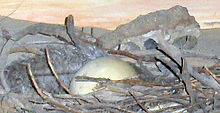
As it was flightless and terrestrial and there were no
I have seen in Mauritius birds bigger than a Swan, without feathers on the body, which is covered with a black down; the hinder part is round, the rump adorned with curled feathers as many in number as the bird is years old. In place of wings they have feathers like these last, black and curved, without webs. They have no tongues, the beak is large, curving a little downwards; their legs are long, scaly, with only three toes on each foot. It has a cry like a gosling, and is by no means so savoury to eat as the Flamingos and Ducks of which we have just spoken. They only lay one egg which is white, the size of a halfpenny roll, by the side of which they place a white stone the size of a hen's egg. They lay on grass which they collect, and make their nests in the forests; if one kills the young one, a grey stone is found in the gizzard. We call them Oiseaux de Nazaret. The fat is excellent to give ease to the muscles and nerves.[6]
Cauche's account is problematic, since it also mentions that the bird he was describing had three toes and no tongue, unlike dodos. This led some to believe that Cauche was describing a new species of dodo ("Didus nazarenus"). The description was most probably mingled with that of a cassowary, and Cauche's writings have other inconsistencies.[77] A mention of a "young ostrich" taken on board a ship in 1617 is the only other reference to a possible juvenile dodo.[78] An egg claimed to be that of a dodo is stored in the East London Museum in South Africa. It was donated by the South African museum official Marjorie Courtenay-Latimer, whose great aunt had received it from a captain who claimed to have found it in a swamp on Mauritius. In 2010, the curator of the museum proposed using genetic studies to determine its authenticity.[79] It may instead be an aberrant ostrich egg.[32]
Because of the possible single-egg clutch and the bird's large size, it has been proposed that the dodo was
A 2017 study examined the
Relationship with humans

Mauritius had previously been visited by
For food the seamen hunt the flesh of feathered fowl,
They tap the palms, and round-rumped dodos they destroy,
The parrot's life they spare that he may peep and howl,
And thus his fellows to imprisonment decoy.[87]
Some early travellers found dodo meat unsavoury, and preferred to eat parrots and pigeons; others described it as tough, but good. Some hunted dodos only for their gizzards, as this was considered the most delicious part of the bird. Dodos were easy to catch, but hunters had to be careful not to be bitten by their powerful beaks.[88]
The appearance of the dodo and the red rail led Peter Mundy to speculate, 230 years before Charles Darwin's theory of evolution:
Of these 2 sorts off fowl afforementionede, For oughtt wee yett know, Not any to bee Found out of this Iland, which lyeth aboutt 100 leagues From St. Lawrence. A question may bee demaunded how they should bee here and Not elcewhere, beeing soe Farer From other land and can Neither fly or swymme; whither by Mixture off kindes producing straunge and Monstrous formes, or the Nature of the Climate, ayer and earth in alltring the First shapes in long tyme, or how.[27]
Dodos transported abroad
The dodo was found interesting enough that living specimens were sent to Europe and the East. The number of transported dodos that reached their destinations alive is uncertain, and it is unknown how they relate to contemporary depictions and the few non-fossil remains in European museums. Based on a combination of contemporary accounts, paintings, and specimens, Julian Hume has inferred that at least eleven transported dodos reached their destinations alive.[89]
Hamon L'Estrange's description of a dodo that he saw in London in 1638 is the only account that specifically mentions a live specimen in Europe. In 1626 Adriaen van de Venne drew a dodo that he claimed to have seen in Amsterdam, but he did not mention if it was alive, and his depiction is reminiscent of Savery's Edwards's Dodo. Two live specimens were seen by Peter Mundy in Surat, India, between 1628 and 1634, one of which may have been the individual painted by Mansur around 1625.[23] In 1628, Emmanuel Altham visited Mauritius and sent a letter to his brother in England:
Right wo and lovinge brother, we were ordered by ye said councell to go to an island called Mauritius, lying in 20d. of south latt., where we arrived ye 28th of May; this island having many goates, hogs and cowes upon it, and very strange fowles, called by ye portingalls Dodo, which for the rareness of the same, the like being not in ye world but here, I have sent you one by Mr. Perce, who did arrive with the ship William at this island ye 10th of June. [In the margin of the letter] Of Mr. Perce you shall receive a jarr of ginger for my sister, some beades for my cousins your daughters, and a bird called a Dodo, if it live.[90]
Whether the dodo survived the journey is unknown, and the letter was destroyed by fire in the 19th century.[91] The earliest known picture of a dodo specimen in Europe is from a c. 1610 collection of paintings depicting animals in the royal menagerie of
One dodo was reportedly sent as far as Nagasaki, Japan, in 1647, but it was long unknown whether it arrived.[75] Contemporary documents first published in 2014 proved the story, and showed that it had arrived alive. It was meant as a gift, and, despite its rarity, was considered of equal value to a white deer and a bezoar stone. It is the last recorded live dodo in captivity.[92]
Extinction

Like many animals that evolved in isolation from significant predators, the dodo was entirely
It has been suggested that the dodo may already have been rare or localised before the arrival of humans on Mauritius, since it would have been unlikely to become extinct so rapidly if it had occupied all the remote areas of the island.[60] A 2005 expedition found subfossil remains of dodos and other animals killed by a flash flood. Such mass mortalities would have further jeopardised a species already in danger of becoming extinct.[96] Yet the fact that the dodo survived hundreds of years of volcanic activity and climatic changes shows the bird was resilient within its ecosystem.[62]
Some controversy surrounds the date of its extinction. The last widely accepted record of a dodo sighting is the 1662 report by shipwrecked mariner Volkert Evertsz of the Dutch ship Arnhem, who described birds caught on a small islet off Mauritius, now suggested to be Amber Island:
These animals on our coming up to them stared at us and remained quiet where they stand, not knowing whether they had wings to fly away or legs to run off, and suffering us to approach them as close as we pleased. Amongst these birds were those which in India they call Dod-aersen (being a kind of very big goose); these birds are unable to fly, and instead of wings, they merely have a few small pins, yet they can run very swiftly. We drove them together into one place in such a manner that we could catch them with our hands, and when we held one of them by its leg, and that upon this it made a great noise, the others all on a sudden came running as fast as they could to its assistance, and by which they were caught and made prisoners also.[97]
The dodos on this islet may not necessarily have been the last members of the species.
The British ornithologist Alfred Newton suggested in 1868 that the name of the dodo was transferred to the red rail after the former had gone extinct.[100] Cheke also pointed out that some descriptions after 1662 use the names "Dodo" and "Dodaers" when referring to the red rail, indicating that they had been transferred to it.[101] He therefore pointed to the 1662 description as the last credible observation. A 1668 account by English traveller John Marshall, who used the names "Dodo" and "Red Hen" interchangeably for the red rail, mentioned that the meat was "hard", which echoes the description of the meat in the 1681 account.[102] Even the 1662 account has been questioned by the writer Errol Fuller, as the reaction to distress cries matches what was described for the red rail.[103] Until this explanation was proposed, a description of "dodos" from 1681 was thought to be the last account, and that date still has proponents.[104]
Cheke stated in 2014 that then recently accessible Dutch manuscripts indicate that no dodos were seen by settlers in 1664–1674.
It is unlikely the issue will ever be resolved, unless late reports mentioning the name alongside a physical description are rediscovered.[95] The IUCN Red List accepts Cheke's rationale for choosing the 1662 date, taking all subsequent reports to refer to red rails. In any case, the dodo was probably extinct by 1700, about a century after its discovery in 1598.[2][102] The Dutch left Mauritius in 1710, but by then the dodo and most of the large terrestrial vertebrates there had become extinct.[38]
Even though the rareness of the dodo was reported already in the 17th century, its extinction was not recognised until the 19th century. This was partly because, for religious reasons, extinction was not believed possible until later proved so by Georges Cuvier, and partly because many scientists doubted that the dodo had ever existed. It seemed altogether too strange a creature, and many believed it a myth. The bird was first used as an example of human-induced extinction in Penny Magazine in 1833,[107] and has since been referred to as an "icon" of extinction.[108]
Physical remains
17th-century specimens
The only extant remains of dodos taken to Europe in the 17th century are a dried head and foot in the
The only known soft tissue remains, the Oxford head (specimen OUM 11605) and foot, belonged to the last known stuffed dodo, which was first mentioned as part of the
Many sources state that the Ashmolean Museum burned the stuffed dodo around 1755 because of severe decay, saving only the head and leg. Statute 8 of the museum states "That as any particular grows old and perishing the keeper may remove it into one of the closets or other repository; and some other to be substituted."[114] The deliberate destruction of the specimen is now believed to be a myth; it was removed from exhibition to preserve what remained of it. This remaining soft tissue has since degraded further; the head was dissected by Strickland and Melville, separating the skin from the skull in two-halves. The foot is in a skeletal state, with only scraps of skin and tendons. Very few feathers remain on the head. It is probably a female, as the foot is 11% smaller and more gracile than the London foot, yet appears to be fully grown.[115] The specimen was exhibited at the Oxford museum from at least the 1860s and until 1998, where-after it was mainly kept in storage to prevent damage.[116] Casts of the head can today be found in many museums worldwide.[111]
The dried London foot, first mentioned in 1665, and transferred to the British Museum in the 18th century, was displayed next to Savery's Edwards's Dodo painting until the 1840s, and it too was dissected by Strickland and Melville. It was not posed in a standing posture, which suggests that it was severed from a fresh specimen, not a mounted one. By 1896 it was mentioned as being without its integuments, and only the bones are believed to remain today, though its present whereabouts are unknown.[23]
The Copenhagen skull (specimen ZMUC 90-806) is known to have been part of the collection of Bernardus Paludanus in
The front part of a skull (specimen NMP P6V-004389) in the National Museum of Prague was found in 1850 among the remains of the Böhmisches Museum. Other elements supposedly belonging to this specimen have been listed in the literature, but it appears only the partial skull was ever present (a partial right limb in the museum appears to be from a Rodrigues solitaire).[23][118][119] It may be what remains of one of the stuffed dodos known to have been at the menagerie of Emperor Rudolph II, possibly the specimen painted by Hoefnagel or Savery there.[120]
Subfossil specimens
Until 1860, the only known dodo remains were the four incomplete 17th-century specimens.
Clark's reports about the finds rekindled interest in the bird. Sir Richard Owen and Alfred Newton both wanted to be first to describe the
In 2005, after a hundred years of neglect, a part of the Mare aux Songes swamp was excavated by an international team of researchers (International Dodo Research Project). To prevent
Louis Etienne Thirioux, an amateur naturalist at Port Louis, also found many dodo remains around 1900 from several locations. They included the first articulated specimen, which is the first subfossil dodo skeleton found outside the Mare aux Songes, and the only remains of a juvenile specimen, a now lost
Worldwide, 26 museums have significant holdings of dodo material, almost all found in the Mare aux Songes. The Natural History Museum,
White dodo
The supposed "white dodo" (or "solitaire") of Réunion is now considered an erroneous conjecture based on contemporary reports of the
Baron Edmond de Sélys Longchamps coined the name Raphus solitarius for these birds in 1848, as he believed the accounts referred to a species of dodo. When 17th-century paintings of white dodos were discovered by 19th-century naturalists, it was assumed they depicted these birds. Oudemans suggested that the discrepancy between the paintings and the old descriptions was that the paintings showed females, and that the species was therefore sexually dimorphic.[138] Some authors also believed the birds described were of a species similar to the Rodrigues solitaire, as it was referred to by the same name, or even that there were white species of both dodo and solitaire on the island.[139]
The Pieter Withoos painting, which was discovered first, appears to be based on an earlier painting by Pieter Holsteyn, three versions of which are known to have existed. According to Hume, Cheke, and Valledor de Lozoya, it appears that all depictions of white dodos were based on Roelant Savery's painting Landscape with Orpheus and the animals, or on copies of it. The painting has generally been dated to 1611, though a post-1614, or even post-1626, date has also been proposed. The painting shows a whitish specimen and was apparently based on a stuffed specimen then in Prague; a walghvogel described as having a "dirty off-white colouring" was mentioned in an inventory of specimens in the Prague collection of the Holy Roman Emperor Rudolf II, to whom Savery was contracted at the time (1607–1611). Savery's several later images all show greyish birds, possibly because he had by then seen another specimen. Cheke and Hume believe the painted specimen was white, owing to albinism.[120][51] Valledor de Lozoya has instead suggested that the light plumage was a juvenile trait, a result of bleaching of old taxidermy specimens, or simply artistic license.[140]
In 1987, scientists described fossils of a recently extinct species of ibis from Réunion with a relatively short beak, Borbonibis latipes, before a connection to the solitaire reports had been made.[141] Cheke suggested to one of the authors, Francois Moutou, that the fossils may have been of the Réunion solitaire, and this suggestion was published in 1995. The ibis was reassigned to the genus Threskiornis, now combined with the specific epithet solitarius from the binomial R. solitarius.[142] Birds of this genus are also white and black with slender beaks, fitting the old descriptions of the Réunion solitaire. No fossil remains of dodo-like birds have ever been found on the island.[120]
Cultural significance
The dodo's significance as one of the best-known extinct animals and its singular appearance led to its use in literature and popular culture as a symbol of an outdated concept or object, as in the expression "dead as a dodo," which has come to mean unquestionably dead or obsolete. Similarly, the phrase "to go the way of the dodo" means to become extinct or obsolete, to fall out of common usage or practice, or to become a thing of the past.[143] "Dodo" is also a slang term for a stupid, dull-witted person, as it was said to be stupid and easily caught.[144][145]
The dodo appears frequently in works of popular fiction, and even before its extinction, it was featured in European literature, as a symbol for exotic lands, and of gluttony, due to its apparent fatness.[146] In 1865, the same year that George Clark started to publish reports about excavated dodo fossils, the newly vindicated bird was featured as a character in Lewis Carroll's Alice's Adventures in Wonderland. It is thought that he included the dodo because he identified with it and had adopted the name as a nickname for himself because of his stammer, which made him accidentally introduce himself as "Do-do-dodgson", his legal surname.[108] Carroll and the girl who served as inspiration for Alice, Alice Liddell, had enjoyed visiting the Oxford museum to see the dodo remains there.[147] The book's popularity made the dodo a well-known icon of extinction.[148] Popular depictions of the dodo often became more exaggerated and cartoonish following its Alice in Wonderland fame, which was in line with the inaccurate belief that it was clumsy, tragic, and destined for extinction.[149]
The dodo is used as a mascot for many kinds of products, especially in Mauritius.[150] It appears as a supporter on the coat of arms of Mauritius, on Mauritius coins, is used as a watermark on all Mauritian rupee banknotes, and features as the background of the Mauritian immigration form.[94][151][152] A smiling dodo is the symbol of the Brasseries de Bourbon, a popular brewer on Réunion, whose emblem displays the white species once thought to have lived there.[153]
The dodo is used to promote the protection of
The name dodo has been used by scientists naming genetic elements, honouring the dodo's flightless nature. A fruitfly gene within a region of a chromosome required for flying ability was named "dodo".[160] In addition, a defective transposable element family from Phytophthora infestans was named DodoPi as it contained mutations that eliminated the element's ability to jump to new locations in a chromosome.[161]
In 2009, a previously unpublished 17th-century Dutch illustration of a dodo went for sale at Christie's and was expected to sell for £6,000.[162] It is unknown whether the illustration was based on a specimen or on a previous image, and the artist is unidentified. It sold for £44,450.[163][48] Parrish suggested it depicts a stuffed specimen, as the legs look dried.[164]
The poet Hilaire Belloc included the following poem about the dodo in his Bad Child's Book of Beasts from 1896:
The Dodo used to walk around,
And take the sun and air.
The sun yet warms his native ground –
The Dodo is not there!
See also
- Holocene extinction
- List of African animals extinct in the Holocene
- List of extinct bird species since 1500
References
- ^ S2CID 85845297.
- ^ . Retrieved 11 November 2021.
- ^ (PDF) from the original on 21 March 2016. Retrieved 28 August 2015.
- ^ Reinhardt, Johannes Theodor (1842–1843). "Nøjere oplysning om det i Kjøbenhavn fundne Drontehoved". Naturhistorisk Tidsskrift (in Danish). IV.: 71–72.
- .
- ^ a b c d Strickland, Hugh Edwin; Melville, A. G. (1848). The Dodo and Its Kindred; or the History, Affinities, and Osteology of the Dodo, Solitaire, and Other Extinct Birds of the Islands Mauritius, Rodriguez, and Bourbon. London: Reeve, Benham and Reeve. pp. 4–112.
- from the original on 10 June 2021. Retrieved 3 June 2021.
- from the original on 10 June 2021. Retrieved 3 June 2021. p. 128.
- .
- from the original on 1 November 2019. Retrieved 28 August 2015.
- ^ .
- PMID 11872833. Archived (PDF) from the original on 20 November 2018. Retrieved 28 August 2015. Supplementary information Archived 5 April 2010 at the Wayback Machine
- ^ BBC (28 February 2002). "DNA yields dodo family secrets". BBC News. London. Archived from the original on 20 October 2002. Retrieved 7 September 2006.
- PMID 17661233.
- ^ S2CID 83711229.
- ^ a b Parish 2013, pp. 134–141.
- ^ PMID 25027719.
- ISBN 978-0-7136-6544-4. pp. 70–71.
- S2CID 28619917.
- ^ Fuller 2001, pp. 37–39.
- ^ S2CID 87957947.
- S2CID 83708873.
- ^ (PDF) from the original on 12 November 2020. Retrieved 11 January 2011.
- ^ Parish 2013, pp. 3–5.
- ^ Hakluyt, Richard (2013) [1812]. A Selection of Curious, Rare and Early Voyages and Histories of Interesting Discoveries. London (UK): R.H. Evans and R. Priestley. Archived from the original on 15 March 2023. Retrieved 14 March 2016. p. 253.
- ^ Fuller 2002, p. 51.
- ^ ISBN 978-0-8014-3954-4. pp. 194–203.
- ^ a b Cheke & Hume 2008, pp. 22–23.
- ^ Fuller 2002, pp. 17–18.
- ^ a b Staub, France (1996). "Dodo and solitaires, myths and reality". Proceedings of the Royal Society of Arts & Sciences of Mauritius. 6: 89–122. Archived from the original on 22 July 2011. Retrieved 21 May 2007.
- ^ Cheke & Hume 2008, p. 276.
- ^ ISBN 978-0-00-714572-0. p. 43.
- ^ Fuller 2002, pp. 147–149.
- ISBN 978-1-59373-002-4. p. 48.
- ^ Fuller 2002, p. 45.
- .
- ^ Parish 2013, pp. 265–282.
- ^ ISBN 978-1-4729-3744-5.
- ^ .
- ^ a b Kitchener, A. C. (28 August 1993). "Justice at last for the dodo". New Scientist. p. 24. Archived from the original on 26 June 2015. Retrieved 26 August 2017.(subscription required)
- ^ S2CID 29215473.
- S2CID 9126864.
- S2CID 30903508.
- PMID 26788418.
- ^ Rothschild, Walter (1907). Extinct Birds. London: Hutchinson & Co. p. 172.
- ^ Fuller 2002, p. 62.
- ^ .
- ^ from the original on 25 July 2022. Retrieved 25 July 2022.
- .
- ISBN 978-1-873240-48-9. Archivedfrom the original on 15 March 2023. Retrieved 12 May 2012. pp. 46–49.
- ^ S2CID 89661119.
- S2CID 23510175.
- ^ Dissanayake, R. (2004). "What did the dodo look like?" (PDF). The Biologist. 51 (3): 165–168. Archived from the original (PDF) on 17 September 2011. Retrieved 14 September 2011.
- S2CID 28617863.
- S2CID 85387209.
- ^ Fuller 2002, pp. 76–77.
- .
- ^ .
- ^ Fuller 2002, p. 23.
- ^ a b Fuller 2002, p. 41.
- ^ Fuller 2002, p. 54.
- ^ hdl:1893/25225.
- S2CID 86670941.
- S2CID 86773685.
- ^ Cheke & Hume 2008, pp. 49–52.
- ^ .
- ^ Fuller 2002, p. 42.
- ^ Cheke & Hume 2008, pp. 37–38.
- ^ Fuller 2002, p. 69.
- .
- S2CID 2392411.
- .
- ^ Herhey, D. R. (2004). "Plant Science Bulletin, Volume 50, Issue 4". Botany.org. Archived from the original on 14 May 2013. Retrieved 12 May 2012.
- JSTOR 3545415.
- ^ a b Cheke & Hume 2008, p. 38.
- ^ Fuller 2002, pp. 43–44.
- ^ Cheke & Hume 2008, p. 27.
- ^ Cheke & Hume 2008, p. 162.
- ^ Laing, A. (27 August 2010). "Last surviving Dodo egg could be tested for authenticity". The Daily Telegraph. London. Archived from the original on 29 August 2010.
- ^ (PDF) from the original on 23 July 2018. Retrieved 6 August 2018. pp. 177–184.
- PMID 28839147.
- ^ Fuller 2002, p. 17.
- S2CID 128421372. p. 93.
- S2CID 4343538.
- ^ Fuller 2002, p. 56.
- (PDF) from the original on 17 March 2012.
- ^ Strickland & Melville 1848, pp. 15.
- ^ Cheke & Hume 2008, pp. 77–78.
- ^ a b Cheke & Hume 2008, pp. 81–83.
- ISBN 978-81-206-1508-3. Archivedfrom the original on 15 March 2023. Retrieved 12 May 2012. p. 83.
- ^ Fuller 2002, p. 60.
- S2CID 86077963.
- ^ BBC (20 November 2003). "Scientists pinpoint dodo's demise". BBC News. London. Archived from the original on 4 April 2020. Retrieved 7 September 2006.
- ^ a b Fryer, J. (14 September 2002). "Bringing the dodo back to life". BBC News. London. Archived from the original on 7 May 2019. Retrieved 7 September 2006.
- ^ a b Cheke & Hume 2008, p. 79.
- ^ Cocks, T. (2006). "Natural disaster may have killed dodos". Australian Broadcasting Corporation. Reuters. Archived from the original on 15 May 2013. Retrieved 30 August 2006.
- ^ Cheke, Anthony S. (2004). "The Dodo's last island" (PDF). Royal Society of Arts and Sciences of Mauritius. Archived (PDF) from the original on 28 March 2016. Retrieved 12 May 2012.
- S2CID 39987650.
- S2CID 4347830.
- ^ Newton, A. (1868). "Recent ornithological publications". Ibis. 4 (2): 479–482. Archived from the original on 3 July 2020. Retrieved 22 July 2020.
- ISBN 978-0-521-11331-1.
- ^ .
- ^ Fuller 2002, pp. 70–73.
- S2CID 83701682.
- S2CID 83978250.
- .
- ^ "The Dodo". The Penny Magazine of the Society for the Diffusion of Useful Knowledge. 2 (75): 209–211. 1 June 1833 – via Internet Archive.
- ^ S2CID 6257901.
- ^ a b Fuller 2002, pp. 116–129.
- .
- ^ S2CID 87191090.
- ^ "Dodo's violent death revealed". warwick.ac.uk. University of Warwick. 2018. Retrieved 4 October 2023.
- ^ Knapton, Sarah (20 April 2018). "Who shot Lewis Carroll's dodo? Forensic scans reveal mystery death". The Telegraph. Archived from the original on 11 January 2022. Retrieved 20 April 2018.
- .
- (PDF) from the original on 5 November 2019. Retrieved 14 September 2011.
- S2CID 87966871.
- ^ Fuller 2002, p. 123.
- ^ Jiří, M. (2012). "Extinct and nearly extinct birds in the collections of the National Museum, Prague, Czech Republic". Journal of the National Museum (Prague) National History Series. 181: 105–106.
- ^ Parish 2013, p. 184–188.
- ^ (PDF) from the original on 5 November 2019. Retrieved 11 January 2011.
- ISSN 0019-1019.
- S2CID 229463078– via Edinburgh University Press.
- ^ Higginson, Harry (1891). Reminiscences of Life and Travel 1859–1872.
- Hume, J. P.(2005). "Contrasting taphofacies in ocean island settings: the fossil record of Mascarene vertebrates". Proceedings of the International Symposium "Insular Vertebrate Evolution: The Palaeontological Approach". Monografies de la Societat d'Història Natural de les Balears. 12: 129–144.
- from the original on 7 November 2020. Retrieved 18 December 2020.
- from the original on 11 September 2017. Retrieved 13 January 2018.
- (PDF) from the original on 24 September 2019. Retrieved 24 September 2019.
- S2CID 128763840.
- ISBN 978-0-520-25649-1. Archivedfrom the original on 15 March 2023. Retrieved 14 March 2016. p. 231.
- ISBN 978-1-84162-410-5. p. 15.
- S2CID 87212166.
- S2CID 220413197.
- Helictite. 42: 13–20.
- ^ Fuller 2002, pp. 123–129.
- ^ Kennedy, M. (21 February 2011). "Half a Dodo found in museum drawer". The Guardian. London. Archived from the original on 4 April 2020. Retrieved 12 May 2012.
- ^ Cheke & Hume 2008, p. 30.
- ^ Rothschild 1907, pp. 172–173.
- JSTOR 4073093.
- ^ Cheke & Hume 2008, pp. 30–31.
- .
- Comptes Rendus de l'Académie des Sciences. Série D (in French). 305 (5): 419–423. Archivedfrom the original on 4 April 2020. Retrieved 10 December 2013.
- Comptes Rendus de l'Académie des Sciences. II a (in French). 320 (SER2, T320, N11): 1125–1131. Archivedfrom the original on 4 April 2020. Retrieved 10 December 2013.
- ^ Fuller 2002, p. 13.
- ^ "dodo". Dictionary.com. Archived from the original on 3 February 2016. Retrieved 27 January 2016.
- ISBN 978-0313294907. Archivedfrom the original on 15 March 2023. Retrieved 27 January 2016.
- from the original on 17 February 2021. Retrieved 25 September 2019.
- ^ a b Fuller 2002, pp. 134–138.
- ^ Mayell, H. (28 February 2002). "Extinct Dodo Related to Pigeons, DNA Shows". National Geographic News. Archived from the original on 17 October 2012. Retrieved 19 January 2009.
- S2CID 237701475.
- ^ Fuller 2002, pp. 140–153.
- ^ "Mauritius new 25- and 50-rupee polymer notes confirmed". banknotenews.com. Archived from the original on 9 January 2015. Retrieved 22 December 2014.
- .
- ^ Cheke & Hume 2008, p. 31.
- ^ Bhookhun, D. P. (2006). "Mauritius: Footprints From the Past". allAfrica.com. Archived from the original on 2 October 2006. Retrieved 26 September 2006.(subscription required) pp. 27–30.
- ^ "Pesticide Peddler Monsanto Wins 2015 Rubber Dodo Award" (Press release). Center for Biological Diversity. 5 November 2015. Archived from the original on 19 November 2015. Retrieved 18 November 2015.
- PMID 21316478.
- (PDF) from the original on 12 August 2016. Retrieved 11 August 2016.
- S2CID 13149434.
- ^ Müller, H. G. (1991). "Stenetriidae from coral reefs at Reunion Island, southern Indian Ocean. Description of three new species". Senckenbergiana Biologica. 71 (4/6): 303–318.
- PMID 8552658.
- S2CID 20240212.
- ^ Jamieson, Alastair (22 June 2009). "Uncovered: 350-year-old picture of Dodo before it was extinct". The Daily Telegraph. London. Archived from the original on 12 November 2012. Retrieved 8 September 2012.
- ^ Christie's (2009). "Dutch School, 17th Century; A dodo". Christies.com. Archived from the original on 17 January 2013. Retrieved 12 May 2012.
- ^ Parish 2013, pp. 104–105.
- ^ Belloc, H. (1896). The Bad Child's Book of Beasts. London: Duckworth. pp. 27–30.
Bibliography
- Parish, Jolyon C. (2013). The Dodo and the Solitaire: A Natural History. Bloomington (US): Indiana University Press. ISBN 978-0-253-00099-6.
External links
- Painting the Dodo: Two-minute video about Julian Hume's modern interpretation of Roelant Savery's Dodo
- Dodo Bird Unboxing: Seven-minute video showing the Oxford specimen being taken out of storage and discussed
- Aves3D – Raphus cucullatus Archived September 23, 2023, at the Wayback Machine: Interactive 3D scans of various dodo elements



